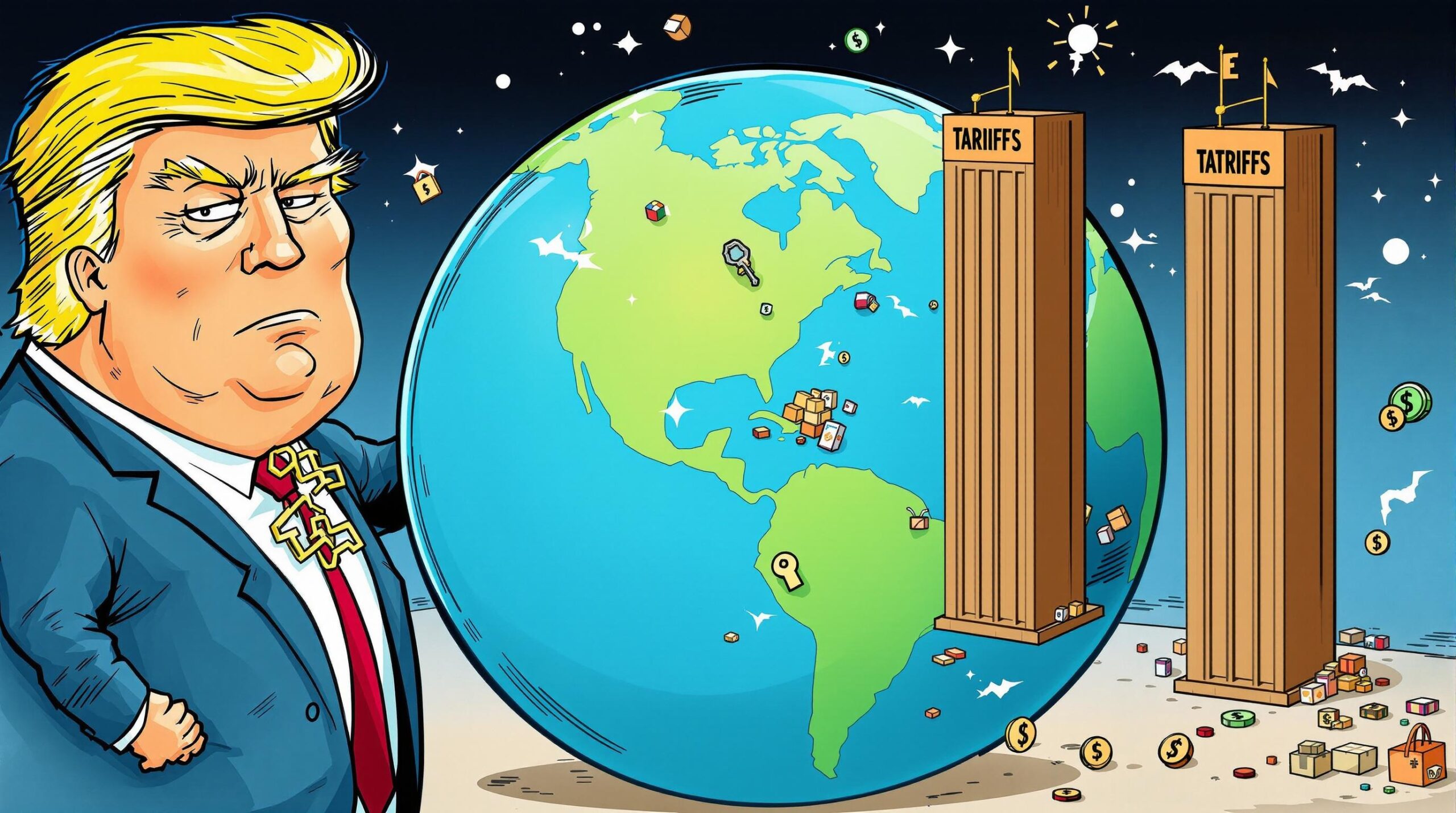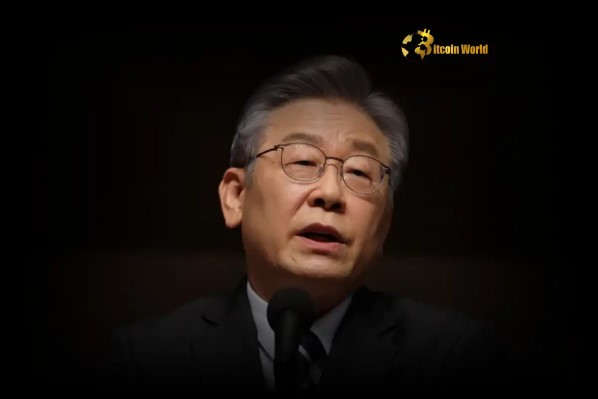BitcoinWorld

Trump Tariffs: Unlocking Global Markets with a Bold New Approach
In an era where global economic policies can shift on a dime, creating ripples that extend far beyond traditional markets, understanding the nuances of international trade is more crucial than ever. For those immersed in the dynamic world of cryptocurrencies, seemingly distant policy shifts, like those concerning Trump tariffs, can unexpectedly influence market sentiment, investor behavior, and even the fundamental demand for decentralized assets. Recent statements from former U.S. President Donald Trump on Truth Social have once again brought the spotlight onto his distinctive approach to trade, signaling a potential return to a policy framework where lower tariffs are directly conditional on a country’s willingness to open its markets. This strategy, a hallmark of his previous administration, carries profound implications not just for international commerce but potentially for the very stability that influences digital asset valuations.
What Are Trump Tariffs and Why Do They Matter for Global Trade?
At its core, a tariff is a tax imposed by a government on goods and services imported from other countries. These taxes are typically used to restrict trade, increase the price of imported goods, and protect domestic industries from foreign competition. While tariffs have been a tool in international trade for centuries, former President Trump’s application of them was marked by a specific philosophy: reciprocity and leverage.
During his previous term, Trump tariffs were often implemented with the explicit goal of forcing other nations to the negotiating table. The underlying belief was that many countries had erected unfair barriers to U.S. goods and services, while the U.S. market remained relatively open. This perceived imbalance, in Trump’s view, necessitated a strong response. His recent statement reinforces this stance, making it clear that tariff reductions are not a given but a reward for market liberalization.
Why does this matter for global trade? Because it challenges the conventional wisdom of multilateral trade agreements and often favors bilateral negotiations. It signals a shift from broad, rules-based trade to a more transactional, conditional approach. This can lead to:
- Increased Bilateral Negotiations: Countries might feel compelled to negotiate directly with the U.S. to avoid higher tariffs.
- Trade Volatility: The unpredictable nature of tariff threats and implementations can create uncertainty for businesses and investors.
- Supply Chain Re-evaluation: Companies may look to diversify their manufacturing and sourcing to mitigate tariff risks.
How Do Trump Tariffs Impact Market Openness and U.S. Businesses?
The central tenet of Trump’s latest declaration is clear: lower tariffs are a reward for countries that agree to open their markets. Conversely, nations unwilling to do so face the prospect of even higher tariffs. This is a direct challenge to existing trade structures and a powerful incentive for other economies to reassess their own trade barriers.
Consider the example of Japan. Trump specifically highlighted that Japan’s markets are now open “for the first time.” While the extent and specific details of this openness are complex and have been subject to ongoing negotiations, Trump’s statement frames it as a direct consequence of his administration’s pressure and a model for future trade relations. For U.S. businesses, this development could be significant:
- Access to New Consumers: If major economies like Japan genuinely open their markets, U.S. companies could gain easier access to millions of new customers for their products and services.
- Reduced Non-Tariff Barriers: Market openness isn’t just about tariffs. It often involves reducing regulatory hurdles, easing licensing requirements, and ensuring fair competition for foreign companies within a domestic market.
- Competitive Advantage: U.S. businesses that can now operate more freely in previously restricted markets might see increased sales and profitability, potentially leading to job growth and economic expansion at home.
However, the impact of Trump tariffs on market openness is a double-edged sword. While some markets might open, others could become more protectionist in response, leading to trade disputes and a fragmentation of the global economy.
Navigating the Waters: The Global Implications of Trump Tariffs
The potential return of a policy emphasizing conditional Trump tariffs sends a clear signal across the global economic landscape. It suggests a more assertive U.S. stance on trade, one that prioritizes perceived fairness and reciprocity over established multilateral frameworks. This approach has several broader implications:
Potential for Trade Wars: The most significant risk is that countries targeted with higher tariffs might retaliate with their own duties on U.S. goods, escalating into a full-blown trade war. Such conflicts can harm global economic growth, increase consumer prices, and disrupt intricate supply chains built over decades.
Shifting Alliances: Nations might find themselves having to choose sides or form new trade blocs to mitigate the impact of U.S. policies. This could reshape geopolitical alliances and economic partnerships.
Impact on Developing Economies: Smaller or developing economies, often reliant on export-led growth, could be particularly vulnerable to sudden shifts in major power trade policies. They might lack the leverage to negotiate favorable terms or absorb the impact of increased tariffs.
Inflationary Pressures: Tariffs are essentially taxes on imports. When applied, they increase the cost of goods for consumers and businesses. This can contribute to domestic inflation, reducing purchasing power and potentially leading to higher interest rates.
Key Considerations for Global Trade Under Conditional Tariffs
| Aspect | Potential Benefit | Potential Challenge |
|---|---|---|
| Market Access | New opportunities for U.S. exporters in opened markets. | Retaliation may close existing markets for U.S. goods. |
| Supply Chains | Incentive to reshore or nearshore production, enhancing resilience. | Disruption, increased costs, and complexity for global businesses. |
| Consumer Prices | Possible lower prices if foreign markets become more competitive. | Higher prices for imported goods due to tariffs. |
| Global Relations | Stronger bilateral trade agreements with specific partners. | Increased international friction and weakened multilateral institutions. |
From Trade Walls to Digital Wallets: How Trump Tariffs Could Influence Crypto?
While Trump tariffs are firmly rooted in traditional economics, their ripple effects can extend into the burgeoning world of digital assets. The interconnectedness of the global economy means that significant shifts in trade policy can influence investor sentiment and capital flows, potentially impacting cryptocurrency markets in several ways:
- Economic Uncertainty and Safe Havens: Increased trade tensions and economic uncertainty, fueled by tariff disputes, can lead investors to seek safe-haven assets. While traditionally gold has filled this role, Bitcoin and other cryptocurrencies are increasingly seen by some as a digital alternative, independent of any single nation’s economic policy.
- Inflationary Hedging: If tariffs lead to higher import costs and domestic inflation, the purchasing power of traditional fiat currencies may erode. This could make cryptocurrencies, particularly those with fixed supplies like Bitcoin, more attractive as a hedge against inflation.
- Push for Decentralization: A world grappling with protectionist trade policies and nationalistic economic agendas might inadvertently highlight the benefits of decentralized, borderless financial systems. Cryptocurrencies, by their nature, are designed to operate without central authority, potentially appealing to those seeking alternatives to traditional, government-controlled financial infrastructures.
- Capital Flight: In scenarios where specific countries face severe economic pressure due to tariffs, capital might seek refuge in more stable or less regulated assets, including cryptocurrencies, leading to increased demand.
It’s important to note that the crypto market is influenced by many factors, and trade policy is just one. However, the macro-economic shifts caused by policies like Trump tariffs are significant enough to warrant attention from crypto investors and enthusiasts.
Actionable Insights: Preparing for the Era of Conditional Trump Tariffs
Whether you’re a business owner, an investor, or simply an observer of global economics, understanding the potential ramifications of these trade policies is key. Here are some actionable insights:
- For Businesses:
- Diversify Supply Chains: Reduce reliance on single countries for sourcing and manufacturing to mitigate tariff risks.
- Monitor Policy Developments: Stay informed about trade negotiations and tariff announcements, especially concerning key markets.
- Assess Market Access: Evaluate opportunities in markets that may open due to U.S. pressure, and prepare to capitalize on them.
- For Investors:
- Understand Macro Trends: Recognize how global trade policies can influence economic stability, inflation, and currency valuations, which in turn affect traditional and digital asset markets.
- Consider Portfolio Diversification: Explore assets that traditionally perform well during periods of economic uncertainty, including potentially certain cryptocurrencies.
- Stay Informed on Geopolitics: Geopolitical tensions often correlate with trade policy shifts and can have a direct impact on market sentiment.
- For Consumers:
- Be Aware of Price Changes: Tariffs can increase the cost of imported goods, impacting everyday purchases.
- Support Local: Increased tariffs on imports might make domestic products more competitive, encouraging local consumption.
Conclusion: A New Chapter in Global Trade?
Donald Trump’s consistent message regarding trade, particularly his recent reiteration on Truth Social about conditional Trump tariffs, signals a clear intent to reshape global commerce. This strategy, demanding market openness in exchange for lower tariffs, aims to level the playing field for U.S. businesses while potentially ushering in a new era of bilateral trade negotiations. While the promise of increased access to foreign markets for American companies is compelling, the path forward is complex, fraught with the potential for trade disputes and economic volatility. For the crypto community, these traditional economic shifts are not isolated events; they contribute to the broader macroeconomic environment that can influence the appeal and performance of digital assets. As the world navigates these evolving trade dynamics, adaptability and informed decision-making will be paramount for businesses, investors, and consumers alike.
Frequently Asked Questions (FAQs)
What exactly are Trump tariffs?
Trump tariffs refer to the import duties (taxes) imposed by former U.S. President Donald Trump’s administrations on goods from various countries. These tariffs were primarily aimed at protecting domestic industries, reducing trade deficits, and compelling trading partners to open their markets or renegotiate trade agreements perceived as unfair.
How do tariffs promote market openness?
The Trump administration’s strategy uses tariffs as leverage. By threatening or imposing higher tariffs, the U.S. aims to pressure countries into removing their own trade barriers, such as non-tariff regulations, quotas, or restrictive licensing requirements, thereby making their markets more accessible for U.S. goods and services. The idea is that countries will open their markets to avoid the economic pain of U.S. tariffs.
What was the outcome of Trump’s trade approach with Japan?
As noted by Donald Trump, Japan’s markets are now considered more open, which he attributes to his administration’s trade strategy. This development likely refers to agreements like the U.S.-Japan Trade Agreement, which reduced tariffs on certain agricultural and industrial products and addressed digital trade issues, leading to increased market access for U.S. goods.
How might these trade policies affect global supply chains?
Conditional tariffs can significantly disrupt global supply chains. Businesses might need to re-evaluate where they source materials and manufacture products to avoid high tariffs. This could lead to reshoring (bringing production back to the U.S.), nearshoring (moving production to neighboring countries), or diversifying supply chains across multiple nations to reduce risk and cost.
Can Trump tariffs indirectly impact cryptocurrency markets?
Yes, indirectly. Trade policies that lead to economic uncertainty, inflation, or geopolitical instability can influence investor behavior. If traditional markets become volatile or less attractive due to tariffs, some investors might seek alternative assets like cryptocurrencies, viewing them as a hedge against economic instability or a decentralized alternative to traditional finance.
Are conditional tariffs a common tool in international trade?
While tariffs are a common trade tool, the explicit and widespread use of them as leverage for broad market openness, as pursued by the Trump administration, represents a more assertive and transactional approach compared to traditional multilateral trade negotiations focused on reciprocal tariff reductions and rules-based systems.
If you found this article insightful, please consider sharing it with your network on social media. Your shares help us bring important economic discussions to a wider audience!
To learn more about the latest global economic trends, explore our article on key developments shaping international trade policy and its future impact.
This post Trump Tariffs: Unlocking Global Markets with a Bold New Approach first appeared on BitcoinWorld and is written by Editorial Team





